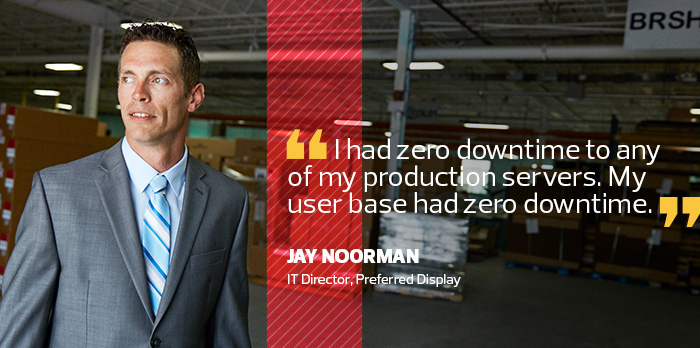5 Data Migration Mistakes Small Businesses Make
Sometimes a business migrates its data to a new platform because it gives the company a business or technology advantage; at other times, it does so because life gives the business no other choice.
Preferred Display, which makes point-of-sale (POS) displays for retailers like Sephora and Macy’s, experienced both when one of its manufacturing facilities caught fire and burned to the ground in 2015.
“The fire in our Glastonbury facility caught and spread quickly. Thankfully, no one was injured, but it resulted in a total loss of the building and all our IT equipment housed onsite along with it,” says Jay Noorman, IT director for the Clifton, N.J., company.
The facility also housed the company’s secondary data center. Even worse, despite his many warnings, Noorman says, it did not have a complete backup offsite — so its data also went up in flames.
Fortunately, Noorman had manually copied much of the information to external drives, and could rebuild much of the email database from Microsoft Exchange server backups and the logs from his Barracuda spam filter.
Noorman used the disaster to upgrade the company’s on-premises storage system from an old HP storage area network to a hyperconverged appliance, Dell EMC’s VxRail. That also meant moving 27 terabytes of data from the spinning disks of its old SAN array to the solid-state memory of the Vx.
Thanks to help from a live migration team and VMware’s Storage vMotion tools, the process at Preferred Display was remarkably pain free, Noorman says.
In all, the data move took three days from start to finish. He migrated noncritical servers during production hours, and critical servers during nonproduction hours.
“I had zero downtime to any of my production servers,” he says. “My user base had zero downtime. Late on the third day, my boss — who is also the CFO — asked when the data migration would be done. I was able to tell him it already was.”
Still, not every data migration project is as well planned or goes as smoothly as Preferred Display’s.
Here are some of the most common data migration mistakes small and medium-sized businesses make, and how to avoid them.
1. Blindly Moving Data to the Cloud
For SMBs without a lot of in-house tech expertise, moving data to the cloud seems like the easiest and most logical choice. In fact, according to IDC, more than 70 percent of companies with between 10 and 99 employees have already adopted cloud services.
“Across every application category, we see a trend toward the cloud because businesses need to keep pace with their competition, and many lack the technical staff to deploy and run IT on-premises,” says Laurie McCabe, co-founder and partner at SMB Group, a research and consulting firm. “For many of them, the only way they can do it is to run their systems in the cloud.”
But even if you’re already using the cloud, storing your data there isn’t always the optimal solution.
Noorman says moving Preferred Display’s data to the cloud was not an option, because the 3D renderings of the POS displays it creates for clients are simply too big. Pulling 2- to 6-gigabyte files from the cloud multiple times a day simply wasn’t going to cut it, he says.
Performance issues are one of the key barriers keeping some SMBs from using the cloud, notes Steven Hill, senior analyst for storage at 451 Research.
“Latency is always the biggest issue because you’ve got the internet between your data and your production environment,” he says. “Once your data gets to a certain size, it becomes much more difficult to move it from point A to point B. On-premises storage will always be faster.”
2. Migrating Junk Data Along with the Relevant Information
Simply migrating all your data from an old platform to a new one is just moving your old problems to a new system, McCabe says.
“The ugly truth is that most databases are filled with a lot of garbage: overlapping information, inconsistent data, multiple records with the same names spelled differently, and so on,” she says. “Before you migrate anything, make sure you’re moving data you plan to continue to use.”
Migration is an excellent opportunity for businesses to clean up their data stores, Noorman agrees. Before Preferred Display migrated its data store, for example, it deleted stale virtual machine disks that had been decommissioned, he says. Then, using the VxRail’s deduplication tools, it managed to shrink 27TB of data down to 23TB on a virtual SAN.

3. Neglecting a Disaster Recovery Plan
Data migration is further complicated by the fact that data rarely resides in one place anymore, Hill says. Some may be on-premises, some may reside in a public or private cloud, and some may be in a hybrid environment.
Companies need to provide for continuity of data and services, no matter where their data resides.
“In the old model, you backed up your data and life was good,” he says. “It pretty much all stayed in one place. When you start spreading your data out across multiple locations, it changes the dynamic. Disaster recovery is now about protecting your workloads and providing consistent availability of services, whether you’re on-premises or in the cloud.”
At the time of its data migration, Preferred Display was relying on local backups using Veeam Software with a cloud connection for storing offsite backups, Noorman says. Now it’s building a private cloud offsite and plans to replicate its mission-critical servers to it.
4. Underestimating the Time and Effort Required for Data Migration
Preferred Display’s migration ran into only a few minor hiccups, most of which involved the settings of its Cisco Systems Catalyst switches. Not every business is as lucky.
“The biggest mistake you see SMBs make is underestimating the challenge of what they’re trying to accomplish,” Hill says. “It involves workloads, data quantities, connectivity speeds and other factors — for companies without a lot of IT resources to fall back on.”
Smaller operations often fail to account for the amount of data cleansing required, the time needed to convert data from disparate sources into the same format and the need to identify dependencies between the data being migrated and other data that isn’t, says Anurag Agrawal, CEO and analyst at Techaisle, a market research firm specializing in SMBs.
His advice? Take the amount budgeted for data migration and double it.
“If you come under that amount, you will be happy,” he adds. “If you go over, it will be only by a small amount. Otherwise, you may find in six months or a year that your data migration process is not complete, and you’ll have to reinvest.”
Agrawal adds that running a pilot migration to a nonproduction server is a good way to get a handle on the time and effort required.
5. Starting Your Data Migration Without Partners
Most storage vendors offer data migration tools, but small IT teams can’t rely on tools alone, Hill says.
“There are a lot of processes involved,” he says. “There are so many moving parts in modern IT, it really helps to get a vendor or service provider to help you make decisions along the way.”
Noorman says CDW played a major role advising and supporting his team, from the initial proposal to hardware evaluation and migrating the data.
“CDW had us work with their Cisco technical team to assess the current network configuration and make required adjustments we did not have the in-house expertise to perform,” he says.
“They then had us work directly with the Dell migration team to perform the live migrations of the servers. During all phases of the project, the entire CDW team provided constant follow-up and assisted with moving the project along at a more-than-acceptable pace.”









